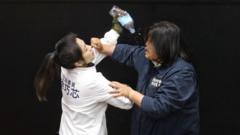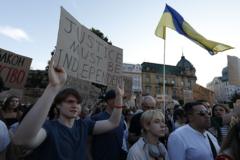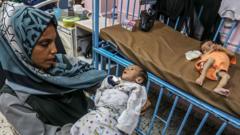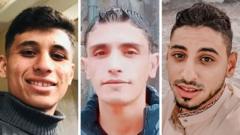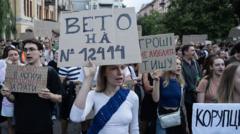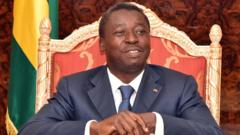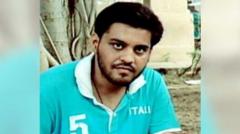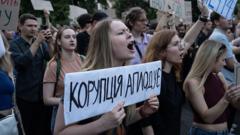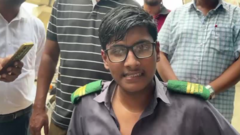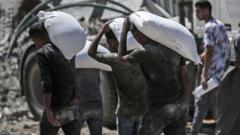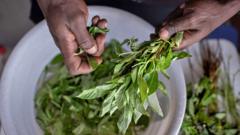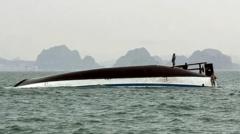A recent report by the Kenyan police watchdog has revealed that law enforcement's use of excessive force during a series of protests has resulted in numerous fatalities.
Kenya's Police Accused of Disproportionate Force Amid Protests

Kenya's Police Accused of Disproportionate Force Amid Protests
The Independent Policing Oversight Authority highlights deadly consequences of police actions during unrest.
The article text:
Kenya's police oversight body has criticized the police for employing "disproportionate force" in response to widespread protests, during which 65 people lost their lives. The Independent Policing Oversight Authority (Ipoa) released the alarming report on Thursday, claiming that the majority of deaths are linked to police actions. Additionally, the report mentions the presence of disruptive individuals, dubbed "goons," who infiltrated the protests and compromised the essence of peaceful demonstration.
Over the last six weeks, protest activity has escalated, driven by public frustration over police brutality and dissatisfaction with government policies. The inaugural demonstration in Nairobi on June 12 was noted as "largely peaceful" following the death of a young teacher and blogger, Albert Ojwang, while in police custody. Initially, police claimed his injuries were self-inflicted, yet subsequent legal actions have resulted in three officers facing charges for his murder.
Protest events continued with a second gathering on June 17, which resulted in the tragic shooting of street vendor Boniface Kariuki at close range; an officer has since been charged for this incident as well. The protest on June 23 marked a year since earlier anti-government unrest, claiming 23 lives across various locations. The most catastrophic event occurred on July 7, leading to the deaths of 41 individuals.
Across four protest days, the watchdog documented 342 civilian injuries and 171 police injuries, alongside instances of looting and vandalism affecting businesses, police stations, and government properties. Ipoa's findings pointed out significant violations of constitutional policing standards, including excessive force, unprofessional behavior, and failure to prioritize public safety and rights.
A police spokesperson refrained from commenting on the report, directing inquiries to an Interior Ministry statement from July 15, which attributed the turmoil to "criminals," "looters," and "anarchists." In response to the July 7 unrest, President William Ruto ordered police to aim for protesters’ legs, aiming to incapacitate rather than kill. He proclaimed a stance that those burning properties should be shot in the leg and later taken into custody, emphasizing a non-lethal approach.
Interior Minister Kipchumba Murkomen has dismissed claims of excessive police force, labeling the protests as a "disguised attempt" to incite terrorism and alter the government unlawfully. Human rights organizations have voiced strong condemnation regarding the government's approach to the protests, alleging that authorities have not only permitted but at times even encouraged lethal force against demonstrators.
Kenya's police oversight body has criticized the police for employing "disproportionate force" in response to widespread protests, during which 65 people lost their lives. The Independent Policing Oversight Authority (Ipoa) released the alarming report on Thursday, claiming that the majority of deaths are linked to police actions. Additionally, the report mentions the presence of disruptive individuals, dubbed "goons," who infiltrated the protests and compromised the essence of peaceful demonstration.
Over the last six weeks, protest activity has escalated, driven by public frustration over police brutality and dissatisfaction with government policies. The inaugural demonstration in Nairobi on June 12 was noted as "largely peaceful" following the death of a young teacher and blogger, Albert Ojwang, while in police custody. Initially, police claimed his injuries were self-inflicted, yet subsequent legal actions have resulted in three officers facing charges for his murder.
Protest events continued with a second gathering on June 17, which resulted in the tragic shooting of street vendor Boniface Kariuki at close range; an officer has since been charged for this incident as well. The protest on June 23 marked a year since earlier anti-government unrest, claiming 23 lives across various locations. The most catastrophic event occurred on July 7, leading to the deaths of 41 individuals.
Across four protest days, the watchdog documented 342 civilian injuries and 171 police injuries, alongside instances of looting and vandalism affecting businesses, police stations, and government properties. Ipoa's findings pointed out significant violations of constitutional policing standards, including excessive force, unprofessional behavior, and failure to prioritize public safety and rights.
A police spokesperson refrained from commenting on the report, directing inquiries to an Interior Ministry statement from July 15, which attributed the turmoil to "criminals," "looters," and "anarchists." In response to the July 7 unrest, President William Ruto ordered police to aim for protesters’ legs, aiming to incapacitate rather than kill. He proclaimed a stance that those burning properties should be shot in the leg and later taken into custody, emphasizing a non-lethal approach.
Interior Minister Kipchumba Murkomen has dismissed claims of excessive police force, labeling the protests as a "disguised attempt" to incite terrorism and alter the government unlawfully. Human rights organizations have voiced strong condemnation regarding the government's approach to the protests, alleging that authorities have not only permitted but at times even encouraged lethal force against demonstrators.



